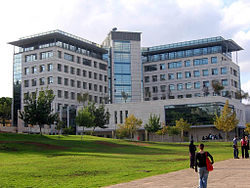Public research and development

Public research and development (Public R&D) refers to the R&D activities related to public sectors, including governments, colleges and non-profit organizations.[2] Public R&D include academic fundamental research, applied research and R&D grants and contracts to private sectors, where later two are known as 'R&D subsidy'. Public R&D could be understood as a funder or a performer of an R&D activity. According to National Science Foundation in U.S., in 2015, R&D expenditures performed by federal governments, local governments, colleges and non-profit organizations are 54, 0.6, 64, and 20 billions of dollars, respectively. Meanwhile, industries perform R&D expenditures of 356 billion dollars. Moreover, R&D expenditures funded by federal governments, local governments, colleges and non-profit organizations are 121, 4.3, 17, and 19 billions of dollars, respectively. R&D expenditures funded by industries are 333 billion dollars.[3] In terms of R&D funders, public R&D to private R&D ratio is about 0.5.
Israel is the world leader as a percentage of GDP in public spending in research and development, the United States leads in total sums spent.
Economic impacts
[edit]Economists have made significant strides to understand the dynamics of public R&D, along with its cascading effects.
Productivity
[edit]Scholars generally propose that public R&D enhances industrial productivity (e.g., Levy and Terleckyj, 1983;[4] Nadiri and Mamuneas, 1994[5]).However, the improvement of productivity could result in R&D spill-over of public sectors, researcher movements and co-operation between public and private sectors.
R&D investment of private sectors
[edit]Economists are particularly concerned about whether public R&D stimulates or crowds out the private sector R&D. It is generally known as a 'policy success', if the public R&D (especially the government R&D subsidy) could stimulate the R&D investment of private sectors. So far, there is no conclusive viewpoint in the literature (e.g., Toole, 2007;[6] Cohen, Coval, and Malloy, 2011;[7] Azoulay, Zivin, Li, and Sampat, 2018[8]).
Stock returns
[edit]Public R&D is also positively related to stock returns of industrial firms (Chen, Chen, Liang, and Wang, 2020).[2] Although they show that abnormal returns based on public R&D ratio generate about 0.9% abnormal returns per month, and suggest that the positive relation could be interpreted by increased cash flow risks.
Government R&D programs
[edit]European Union
[edit]The EU spent €352 billion on R&D in 2022, 2.22% of EU GDP.[9] R&D as a percentage of GDP was highest in Belgium (3.44%), followed by Sweden (3.40%), Austria (3.20%) and Germany (3.13%) as of 2022.[9]
-
Secop R&D Center in Gleisdorf Austria
-
IBM Germany Research & Development
Israel
[edit]Israel leads the world in spending as a percentage of the economy on Research and development.[10] Israel spent 6.02% of its GDP on R&D.[11] Israel has focused on development on human capital investment with significant investment going toward knowledge based sectors of the economy.[12]
-
Microsoft Israel R&D Center
-
General Motors R&D, Israel
-
Technion, Computer Science faculty
-
Weizmann Institute, koffler accelerator
-
Israeli StemRad astronaut anti radiation suit, picture by NASA
United States
[edit]The United States spends the most on R&D in pure terms of investment. Federal research and development budget in the fiscal year of 2020 was $156 billion.[13]
-
The Jet Propulsion Laboratory, California
-
Learning Research and Development Center, Pittsburg
-
Mercedes Benz Research Development North America
-
National Museum of the U.S. Air Force-Research and Development Gallery
References
[edit]- ^ Anderson, G.; Moris, F. (2023). "Federally Funded R&D Declines as a Share of GDP and Total R&D". National Science Foundation, National Center for Science and Engineering Statistics. Archived from the original on 3 October 2023.
NSF 23-339
- ^ a b Chen, Sheng-Syan; Yan-Shing Chen; Woan-lih Liang; Yanzhi Wang. (2020). "Public R&D spending and cross-sectional stock returns". Research Policy. 49 (1): 103887. doi:10.1016/j.respol.2019.103887.
- ^ "Research and Development: U.S. Trends and International Comparisons, National Science Foundation" (PDF).
- ^ Levy, David M.; Nestor E. Terleckyj (1983). "Effects of government R&D on private R&D investment and productivity: A macroeconomic analysis". The Bell Journal of Economics. 14 (2): 551–561. doi:10.2307/3003656. JSTOR 3003656.
- ^ Mamuneas, Theofanis P.; M. Ishaq Nadiri (1996). "Public R&D policies and cost behavior of the US manufacturing industries" (PDF). Journal of Public Economics. 63: 57–81. doi:10.1016/S0047-2727(96)01588-5.
- ^ Toole, Andrew A. (2007). "Does public scientific research complement private investment in research and development in the pharmaceutical industry?". The Journal of Law and Economics. 50: 81–104. doi:10.1086/508314. S2CID 44436555.
- ^ Cohen, Lauren; Joshua Coval; Christopher Malloy (2011). "Do powerful politicians cause corporate downsizing?" (PDF). Journal of Political Economy. 119 (6): 1015–1060. doi:10.1086/664820. S2CID 3148523.
- ^ Azoulay, P.; Graff Zivin, J. S.; Li, D.; Sampat, B. N. (2019). "Public R&D investments and private-sector patenting: evidence from NIH funding rules". The Review of Economic Studies. 86 (1): 117–152. doi:10.1093/restud/rdy034. PMC 6818650. PMID 31662587.
- ^ a b "EU expenditure on R&D reaches €352 billion in 2022 - Eurostat". ec.europa.eu. Retrieved 2024-07-03.
- ^ "R&D as a percentage of GDP by country 2022". Statista. Retrieved 2024-07-03.
- ^ "R&D as a percentage of GDP by country 2022". Statista. Retrieved 2024-07-02.
- ^ "השקעות במו"פ אזרחי בישראל: נתונים כבסיס לדיון לשם גיבוש מדיניות לאומית". www.neaman.org.il. Retrieved 2024-07-03.
- ^ "Federal Research and Development (R&D) Funding: FY2021". 17 December 2020. Retrieved 20 February 2021.











